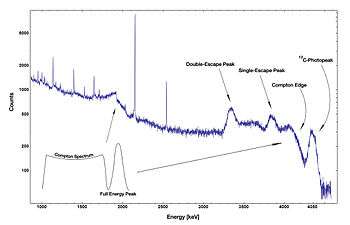Compton edge
In spectrophotometry, the Compton edge is a feature of the spectrograph that results from the Compton scattering in the scintillator or detector. When a gamma-ray scatters off the scintillator but escapes, only some fraction of its energy is registered by the detector. The amount of energy deposited in the detector depends on the scattering angle of the photon, leading to a spectrum of energies each corresponding to a different scattering angle. The highest energy that can be deposited, corresponding to full back-scatter, is called the Compton edge.
Background

In a Compton scattering process, an incident photon collides with an electron in a material. The amount of energy exchanged varies with angle, and is given by the formula:
or
- E is the energy of the incident photon.
- E' is the energy of the outgoing photon, which escapes the material.
- is the mass of the electron.
- c is the speed of light.
- is the angle of deflection for the photon.
The amount of energy transferred to the material varies with the angle of deflection. As approaches zero, none of the energy is transferred. The maximum amount of energy is transferred when approaches 180 degrees.
It is impossible for the photon to transfer any more energy via this process, hence there is a sharp cutoff at this energy giving rise to the name Compton edge.